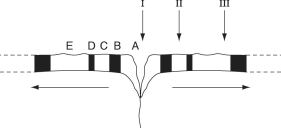The following questions refer to the description and figure below.
The figure represents a cross section of the sea floor through a mid-ocean rift valley, with alternating patches of black and white indicating sea floor with reversed magnetic polarities. At the arrow labeled "I" (the rift valley) , the igneous rock of the sea floor is so young that it can be accurately dated using carbon-14 dating. At the arrow labeled "III," however, the igneous rock is about 1 million years old, and potassium-40 dating is typically used to date such rocks. NOTE: the dashed horizontal arrows indicate the direction of sea-floor spreading, away from the rift valley.
 Figure 25.1
Figure 25.1
-Argon-40, the daughter isotope of potassium-40, is a gas. Elemental potassium has an atomic mass of about 39. If the submersible robot (which is equipped with a drill that is long enough to get to the igneous rock) ascends from depth too quickly, gases trapped within igneous rock may rapidly expand, fracture the rock, and escape from the sample before it can be dated aboard the floating research vessel. Rock samples can also absorb argon gas. Which of these techniques has the highest chance of providing inaccurate dates of igneous rocks distant from the rift valley, and what type of inaccuracy would it cause?
Definitions:
Sensitization
An increased reactivity to all environmental events following exposure to an intense stimulus.
Behavioral Contrast
A phenomenon in which a change in the reinforcement conditions of one behavior leads to an opposite change in the rate of another behavior.
Opponent Process
A theory suggesting that emotions are regulated by mechanisms that operate in opposing pairs.
Q5: Arrange the following structures from largest to
Q17: If two genes from one RNA molecule
Q22: What is the most probable explanation for
Q23: Which of the following features of prokaryotic
Q35: Plant spores are produced directly by<br>A)sporophytes.<br>B)gametes.<br>C)gametophytes.<br>D)gametangia.<br>E)seeds.
Q50: Which conclusion is consistent with the data
Q55: Which feature of honeybees probably arose under
Q56: Which of the following is most likely
Q56: Assuming that the rate of sea-floor spreading
Q73: Loss of soil nitrogen via "gaseous emission"